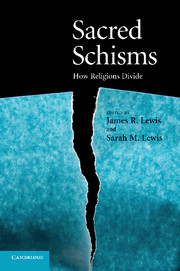Book contents
- Frontmatter
- Contents
- List of figures
- Notes on contributors
- Acknowledgments
- Introduction
- PART I THEORETICAL OVERVIEW
- PART II SURVEY OF SCHISMS IN SELECTED TRADITIONS
- PART III CHRISTIAN TRADITIONS
- 5 Finishing the Mystery: the Watch Tower and “the 1917 schism”
- 6 Challenges to charismatic authority in the Unificationist Movement
- 7 Persecution and schismogenesis: how a penitential crisis over mass apostasy facilitated the triumph of Catholic Christianity in the Roman Empire
- PART IV WESTERN ESOTERIC TRADITIONS
- PART V NON-WESTERN/POSTCOLONIAL TRADITIONS
- Index
- References
5 - Finishing the Mystery: the Watch Tower and “the 1917 schism”
Published online by Cambridge University Press: 24 October 2009
- Frontmatter
- Contents
- List of figures
- Notes on contributors
- Acknowledgments
- Introduction
- PART I THEORETICAL OVERVIEW
- PART II SURVEY OF SCHISMS IN SELECTED TRADITIONS
- PART III CHRISTIAN TRADITIONS
- 5 Finishing the Mystery: the Watch Tower and “the 1917 schism”
- 6 Challenges to charismatic authority in the Unificationist Movement
- 7 Persecution and schismogenesis: how a penitential crisis over mass apostasy facilitated the triumph of Catholic Christianity in the Roman Empire
- PART IV WESTERN ESOTERIC TRADITIONS
- PART V NON-WESTERN/POSTCOLONIAL TRADITIONS
- Index
- References
Summary
INTRODUCTION
To the believer, distinctions between orthodox and schismatic, and between the authentic and the inauthentic, seem obvious. To the Jehovah's Witness, there seems an obvious continuity between the Watch Tower Bible and Tract Society, founded by Charles Taze Russell, and the present-day Jehovah's Witnesses, so named in 1931 by their second leader, Joseph Franklin Rutherford. Viewed superficially, a split in a religious organization appears to arise when a subversive leader rises to a position of power, gathers a following that challenges the orthodox teachings of the movement, fails to bring the entire movement to accept his teachings or authority, and subsequently secedes to form his own organization. As is frequently pointed out, however, history tends to be written by the victors, and hence the minority becomes allowed to disappear into relative oblivion.
This chapter focuses on the 1917 split within the Society, with particular reference to the controversies surrounding the Paul Johnson movement, and my aim is to examine the main causes of the schism that surrounded J. F. Rutherford's rise to power. In what follows, I shall argue that the so-called schisms of this period cannot be explained in such a simplistic manner. Indeed, even to refer to it as a “split” is to over-simplify the issues surrounding the dispute. Despite the fact that present-day Jehovah's Witnesses form a coherent unified organization with clear central authority, such a claim could not be made of the Watch Tower organization at the end of Russell's presidency.
- Type
- Chapter
- Information
- Sacred SchismsHow Religions Divide, pp. 109 - 128Publisher: Cambridge University PressPrint publication year: 2009
References
Accessibility information
- 1
- Cited by

